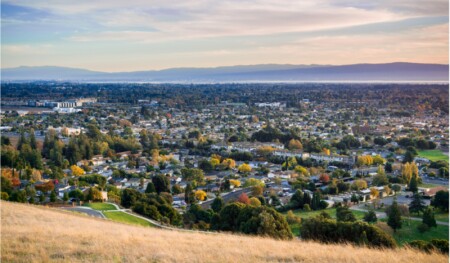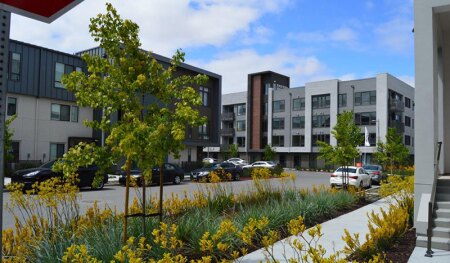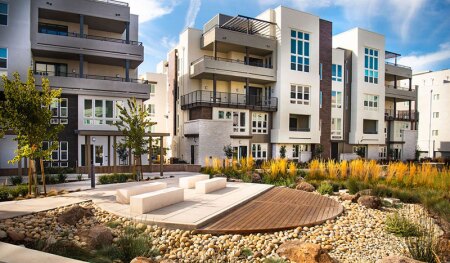In 2010, the San Francisco Bay area city of Fremont faced a seismic challenge. After decades of producing hundreds of thousands of automobiles each a year and employing hundreds of well-paid workers, the expansive New United Motor Manufacturing Inc. (NUMMI) plant, a collaboration between General Motors and Toyota, announced that it would be closing its doors.
“Until that moment, no one had ever thought of doing anything different than leaving a bunch of space around NUMMI for them to continue as the large employer and force that they were,” says Joel Pullen, planning manager for the city of Fremont. “When they shut down operations, it created this black hole.”
The worst nightmares of policymakers like Pullen soon manifested in the news that the Union Pacific Rail Road announced that it wanted to acquire part of the site for a vast railyard. Bay Area Rapid Transit (BART) leaders had long planned to build a new station by the car manufacturer, and there were few less transit-friendly options for its new neighbor than a tangle of tracks and train sheds.
Decades in the Making
Over a decade later, the outcome looks quite different. Where once an industrial expanse was planned, there is now the Warm Springs Innovation District. The NUMMI facility was purchased by Tesla, which in the ensuing decade became a manufacturing behemoth, employing thousands at the site. Thousands of apartments and a new elementary school have accompanied a burst of development.
“The speed that we were able to accomplish what we accomplished out here was pretty shocking,” says Pullen. “It’s been a bright spot in our growth for some time. Here we are, with construction prices up and post-COVID adjustments, but they’re still building it out and there are still people still moving in.”
Fremont’s community visioning process at the crisis moment in the wake of the Great Recession resulted in a proposal for the area around the future BART station (which opened in 2017) as a home for 20,000 jobs and 4,000 residential units. The master plan and accompanying zoning rules were put in place in 2015.
Today, construction is almost 70 percent complete in the Warm Springs innovation district. Most of the housing developments, both market rate and affordable, are done, with more units are on the way. The elementary school is open and accepting students. A system of parks and greenways connects all this new construction, offering ways for pedestrians and bicyclists to maneuver around the site. The streets are designed for the safe travel of cars, bikes, and pedestrians.
Pullen says that a 2012 Urban Land Institute panel helped speed the planning process forward, giving “real heavy-hitting credence” to their choices about transit-oriented development. The affirmation brought by that panel really got the interest of the development industry, he says, and locked in political attention, too.
That is when Casey Case, who did much of the landscape architecture work for the project, got involved. Her firm, Gates + Associates, worked on the market rate housing projects by the Lennar Corporation and the Toll Brothers, at the St. Anton affordable housing development, the Lila Bringhurst park, and the BART station’s public plaza.
Case says that the experience was different from previous projects she worked on in the area. That is part of why it was an exciting opportunity: a chance to work on a project that didn’t put cars first and gave residents a chance to utilize other forms of transportation.
“There was such an emphasis on transit and walkability and a higher density than had previously been done in Fremont,” said Case. “There was an emphasis on [making sure] people felt safe, they felt the connectivity, they felt socially connected with their neighbors, and that they felt the opportunity to maybe not have five cars per household.”
Challenges to Come
Despite its successes, the Warm Springs Innovation District faces myriad challenges. Much of the mixed-use development on the west side of the BART station was divided from the transit node by multiple Union Pacific rail lines. That has made life more difficult than it needs to be for commuters and residents, and a new pedestrian bridge that opened this past fall is expected to ease this pinch.
Then there’s the COVID-19 pandemic, which has sent public transit ridership plunging across the country. BART is no different and as the Omicron variant spreads with virulent speed, ridership could be in danger again. If ridership takes a long time to recover, and if BART is forced to reduce service due to fare declines, the mixed-use and transit-oriented dream of Warm Springs could be frustrated.
But Pullen, for one, is optimistic. As the pandemic rumbles on, he believes that ridership will normalize and eventually probably recover to pre-COVID levels.
“If the pandemic turns into a kind of a long slog, and it’s a recurring annual thing, then transit ridership is going to regularize and all the things that go along with the transit-oriented development will even out,” says Pullen.
He’s also optimistic that BART will continue with its expansion plans, potentially bringing more riders to Warm Springs and its job hub. After the transit system’s original construction in the 1970s, this line ended in downtown Fremont for a long time. The Warm Springs expansion, and its accompanying Innovation District, then became the southernmost stop.
In 2020, two stations opened in north San Jose, making Fremont no longer the end of the line. Stations for downtown San Jose are planned for 2029 or 2030.
“When it goes to San Jose, you’ll have people going both directions and coming through Fremont,” says Pullen. “Will that increase the amount of people who choose to come to Fremont on a weekend? The number of people who have other options for where to live if they work in San Jose? When it goes to both San Jose and San Francisco that’s going to change the dynamic of a lot of these formerly end-of-the-line stations.”
Articles on Advisory Services:
- Think Big, Think Legacy: ULI Advisory Services Panel Recommendations for One of America’s Fastest-Growing Regions
- Advisory Services Spotlight: Hong Kong
- ULI Advisory Services: 70-Plus Years of Creative Solutions
More Advisory Services reports on Knowledge Finder:







